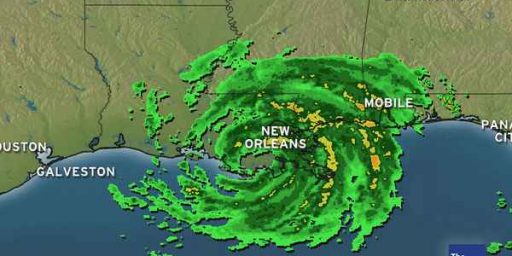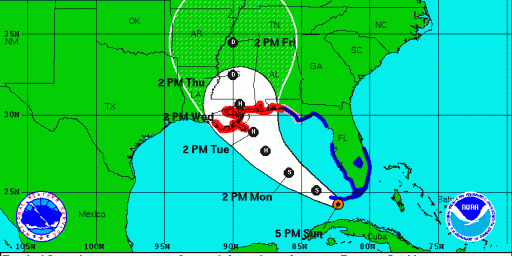Hurricane Katrina Hits New Orleans
After three days of gleeful anticipation by the news media, Hurricane Katrina has hit land in Louisiana.
Hurricane Katrina Makes Landfall in La. (AP)
Hurricane Katrina slammed ashore early Monday and charged toward this low-lying city with 150-mph winds and the threat of a catastrophic storm surge. Katrina edged slightly to the east shortly before making landfall near Grand Isle, providing some hope that the worst of the storm’s wrath might not be directed at the vulnerable city. Martin Nelson, a meteorologist at the National Hurricane Center, said the northern part of the eyewall came ashore at about 5 a.m. central time.
Katrina’s fury was quickly felt at the Louisiana Superdome, normally home of professional football’s Saints, which became the shelter of last resort Sunday for about 9,000 of the area’s poor, homeless and frail. Electrical power at the Superdome failed at 5:02 a.m., triggering groans from the crowd. Emergency generators kicked in, but the backup power runs only reduced lighting and is not strong enough to run the air conditioning.
Bill Nienhuis has a roundup of weather resources, news coverage, and blogger reactions entitled, “Goodbye Big Easy.” One gathers from the early news coverage that such a catastrophe will be averted, although substantial damage will occur.
My parents had Fox News Channel on much of the weekend and the reporters, especially on the insipid morning show, seemed very excited about the whole thing, as if this were a summer blockbuster instead of people’s lives. Of course, they did much the same thing the last time New Orleans was in the path of a major hurricane. The constant refrain of “Fox News Alert!” for non-breaking, routine coverage was incredibly annoying.
This isn’t a Fox-specific phenomenon, of course. The local news channels have been hyping the weather for years, competing as to who can start continual live coverage of breaking weather news first and on whose Super Duper Ultra-Special Doppler Weather Radar Mark XVII can most accurately pinpoint the path of destruction.
Updated AP story: Katrina Charges Toward New Orleans
Hurricane Katrina slammed ashore early Monday and charged toward this below-sea-level city with 145-mph winds and the threat of a catastrophic storm surge. Katrina edged slightly to the east shortly before making landfall near Grand Isle, providing some hope that the worst of the storm’s wrath might not be directed at the vulnerable city.
[…]
Even though the storm was hours away from New Orleans, Karina’s advance winds were already blowing slate tiles off the old roofs of the French Quarter. The wind was blowing the rain sideways, and debris was carried up more than 100 feet. Power was on and off in sections of the city, and emergency vehicles patrolled the main streets, their blue and red lights flashing.
“I’d rather watch this than watch a movie,” said Steven Grades, 22, one of the Superdome evacuees as he looked out through the windows at the gathering storm.
For updates, see the Weather Channel’s Hurricane Central.





May I Ask where Hurricane Katrina first started out at. How is it doing now. I need to find the information on how many have survived from this tragic event. How long until this whole thing is over with?